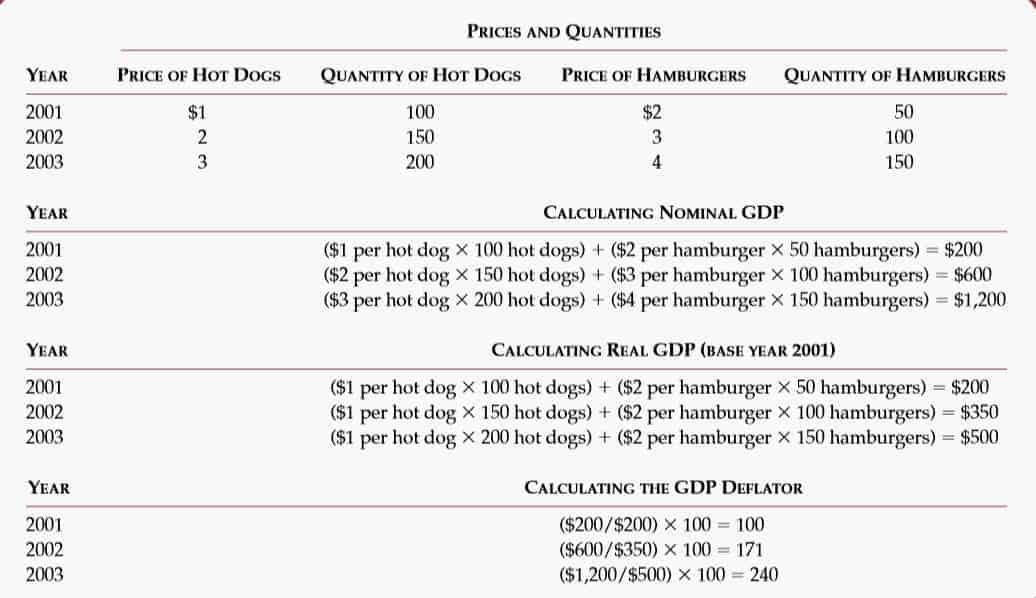Nominal GDP uses current prices to place a value on the economy’s production of goods and services. Real GDP uses constant base-year prices to place a value on the economy’s production of goods and services.
Because real GDP is not affected by changes in prices, changes in real GDP reflect only changes in the amounts being produced.
Thus, real GDP is a measure of the economy’s production of goods and services.
Breaking down Real vs Nominal GDP
GDP measures the total spending on goods and services in all markets in the economy. If total spending rises from one year to the next, one of two things must be true:
- The economy is producing a larger output of goods and services, or
- Goods and services are being sold at higher prices.
When studying changes in the economy over time, economists want to separate these two effects.
In particular, they want a measure of the total quantity of goods and services the economy is producing that is not affected by changes in the prices of those goods and services.
To do this, economists use a measure called real GDP.
Real GDP answers a hypothetical question: What would be the value of the goods and services produced this year if we valued these goods and services at the prices that prevailed in some specific year in the past?
By evaluating current production using prices that are fixed at past levels, real GDP shows how the economy’s overall production of goods and services changes over time.
To see more precisely how real GDP is constructed, let’s consider an example.
A NUMERICAL EXAMPLE
The table below shows some data for an economy that produces only two goods, hot dogs and hamburgers.

The table shows the quantities of the two goods produced and their prices in the years 2001, 2002, and 2003.
To compute total spending in this economy, we would multiply the quantities of hot dogs and hamburgers by their prices.
In the year 2001, 100 hot dogs are sold at a price of $1 per hot dog, so expenditure on hot dogs equals $100.
In the same year, 50 hamburgers are sold for $2 per hamburger, so expenditure on hamburgers also equals $100.
Total expenditure in the economy—the sum of expenditure on hot dogs and expenditure on hamburgers—is $200. This amount, the production of goods and services valued at current prices, is called nominal GDP.
The table shows the calculation of nominal GDP for these three years. Total spending rises from $200 in 2001 to $600 in 2002 and then to $1,200 in 2003.
Part of this rise is attributable to the increase in the quantities of hot dogs and hamburgers, and part is attributable to the increase in the prices of hot dogs and hamburgers.
To obtain a measure of the amount produced that is not affected by changes in prices, we use real GDP, which is the production of goods and services valued at constant prices.
We calculate real GDP by first choosing one year as a base year.
We then use the prices of hot dogs and hamburgers in the base year to compute the value of goods and services in all of the years.
In other words, the prices in the base year provide the basis for comparing quantities in different years.
Suppose that we choose 2001 to be the base year in our example.
We can then use the prices of hot dogs and hamburgers in 2001 to compute the value of goods and services produced in 2001, 2002, and 2003.
The
To compute real GDP for 2001, we use the prices of hot dogs and hamburgers in 2001 (the base year) and the quantities of hot dogs and hamburgers produced in 2001.
Thus, for the base year, real GDP always equals nominal GDP.
To compute real GDP for 2002, we use the prices of hot dogs and hamburgers in 2001 (the base year) and the quantities of hot dogs and hamburgers produced in 2002.
Similarly, to compute real GDP for 2003, we use the prices in 2001 and the GDP by in 2003.
When we find that real GDP has risen from $200 in 2001 to $350 in 2002 and then to $500 in 2003.
We know that the increase is attributable to an increase in the quantities produced because the prices are being held fixed at base-year levels
To Summarise Real vs Nominal GDP
Our goal in computing GDP is to gauge how well the overall economy is performing.
Because real GDP measures the economy’s production of goods and services, it reflects the economy’s ability to satisfy people’s needs and desires.
Thus, real GDP is a better gauge of economic well-being
When economists talk about the economy’s GDP, they usually mean real GDP rather than nominal GDP.
And when they talk about growth in the economy, they measure that growth as the percentage change in real GDP from one period to another.
